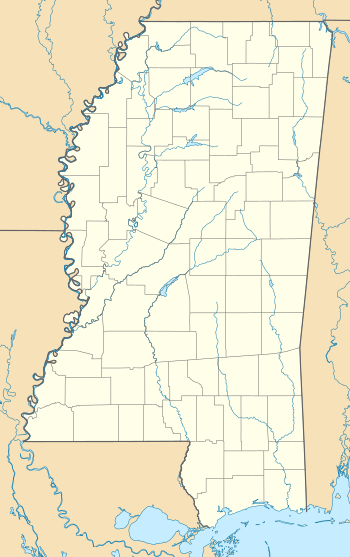Wyolah Plantation
The Wyolah Plantation is a historic Southern plantation in Church Hill, Jefferson County, Mississippi.[2][3][4] It is located off the Mississippi Highway 553.[3]
Wyolah Plantation | |
  | |
| Location | Church Hill, Mississippi |
|---|---|
| Coordinates | 31°42′7.56″N 91°14′49.78″W |
| Area | 60.4 acres (24.4 ha) |
| Architectural style | Greek Revival architecture |
| NRHP reference No. | 85001168[1] |
| Added to NRHP | May 30, 1985 |
Overview
The Wyolah Plantation owner's house was built for Dr. Francis B. Coleman before the Civil War.[4] The architectural style of the plantation house is Greek Revival.[2][5] It is thought that maybe Dr. Coleman named Wyolah after a place in Ireland.[6] Dr. Coleman owned 81 slaves in Jefferson County, Mississippi in the 1860 census.[7]
Dr. Coleman had a medical practice in Rodney, Mississippi and at his nearby Wyolah Plantation.[8] In the WPA Slave Narrative Collection for the state of Arkansas, former Jefferson County, Mississippi slave Peter Brown told of a time when he was a slave on David Hunt's Woodlawn Plantation and Dr. Coleman came to care for his parents, who had contracted cholera.[9] In 1846 Doctor Coleman went to Mount Locust Plantation in Jefferson County to vaccinate some slaves.[10]
Dr. Coleman and his friend Thomas Affleck published a horticulture-related journal from Wyolah Plantation.[8]
Wyolah was purchased by the Reddy family, and later by the Thomas O'Quinn, Jr. family.[11] In 1984 Wyolah was owned by Dr. James W. and Juel F. Delasho and consisted of 110.44 acres, of which 60.44 acres was nominated as a historic site.[12] It has been listed on the National Register of Historic Places since May 30, 1985.[2][3]
As of 2016, producer Tate Taylor is the owner of Wyolah.[6]
References
- "National Register Information System". National Register of Historic Places. National Park Service. July 9, 2010.
- National Register of Historic Places
- Nancy Capace, Encyclopedia of Mississippi, North American Book Distribution, 2001, p. 499
- Miller, Mary. "National Register of Historic Places — Registration Form". United States Department of the Interior National Park Service. Retrieved October 31, 2017.
- Patti Carr Black, Art in Mississippi, 1720–1980, Jackson, Mississippi: University Press of Mississippi, 1998, p. 58
- "Tour The Help Director Tate Taylor's Renovated 1830s Mississippi Mansion". Architectural Digest. February 2, 2016.
- Rudd, Linda. "1860 Jefferson County Slave Schedule – Mississippi". angelfire.com. Retrieved January 11, 2018.
- "UNKNOWN". Jackson, Mississippi: Clarion-Ledger. June 10, 1973. p. 12. Retrieved January 11, 2018 – via Newspapers.com.
- Robertson, Irene. "Peter Brown. Helena, Arkansas". Slave narratives, Arkansas Part I. Slave Narratives: a Folk History of Slavery in the United States. United States Work Projects Administration. Retrieved January 11, 2018 – via Project Gutenberg.
- Brignac, Kelly. "Exploring Race and Medicine through Diaries: White Perspective on Slave Medical Care in Antebellum Mississippi" (PDF). Indiana.edu. Retrieved January 11, 2018.
- Logan, Marie (1980). Mississippi-Louisiana Border Country (2nd ed.). Baton Rouge, Louisiana: Claitor's Publishing Division. p. 205.
- Miller, Mary. "National Register of Historic Places Inventory — Nomination Form" (PDF). United States Department of the Interior Heritage Conservation and Recreation Service. Retrieved January 11, 2018.
External links
- "Tour The Help Director Tate Taylor's Renovated 1830s Mississippi Mansion". Architectural Digest. February 2, 2016.